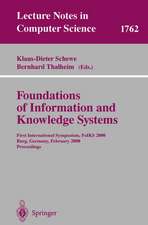Entity-Relationship Approach - ER '93: 12th International Conference on the Entity-Relationship Approach, Arlington, Texas, USA, December 15 - 17, 1993. Proceedings: Lecture Notes in Computer Science, cartea 823
Editat de Ramez A. Elmasri, Vram Kouramajian, Bernhard Thalheimen Limba Engleză Paperback – 28 iul 1994
The volume presents many of the most important results on the ERA published since the predecessor conference ER '92. It is organized in sections on object-oriented models, query languages, applications of the ER model, knowledge-based modeling, data modeling, schema integration, reuse and reengineering, integrating ER and object-orientation, conceptual clustering, modeling time and data semantics.
Din seria Lecture Notes in Computer Science
- 20%
 Preț: 1061.55 lei
Preț: 1061.55 lei - 20%
 Preț: 340.32 lei
Preț: 340.32 lei - 20%
 Preț: 341.95 lei
Preț: 341.95 lei - 20%
 Preț: 453.32 lei
Preț: 453.32 lei - 20%
 Preț: 238.01 lei
Preț: 238.01 lei - 20%
 Preț: 340.32 lei
Preț: 340.32 lei - 20%
 Preț: 438.69 lei
Preț: 438.69 lei -
 Preț: 449.57 lei
Preț: 449.57 lei - 20%
 Preț: 343.62 lei
Preț: 343.62 lei - 20%
 Preț: 148.66 lei
Preț: 148.66 lei - 20%
 Preț: 310.26 lei
Preț: 310.26 lei - 20%
 Preț: 256.27 lei
Preț: 256.27 lei - 20%
 Preț: 645.28 lei
Preț: 645.28 lei - 17%
 Preț: 427.22 lei
Preț: 427.22 lei - 20%
 Preț: 655.02 lei
Preț: 655.02 lei - 20%
 Preț: 307.71 lei
Preț: 307.71 lei - 20%
 Preț: 1075.26 lei
Preț: 1075.26 lei - 20%
 Preț: 591.51 lei
Preț: 591.51 lei -
 Preț: 381.21 lei
Preț: 381.21 lei - 20%
 Preț: 337.00 lei
Preț: 337.00 lei - 15%
 Preț: 438.59 lei
Preț: 438.59 lei - 20%
 Preț: 607.39 lei
Preț: 607.39 lei - 20%
 Preț: 538.29 lei
Preț: 538.29 lei -
 Preț: 389.48 lei
Preț: 389.48 lei - 20%
 Preț: 326.98 lei
Preț: 326.98 lei - 20%
 Preț: 1414.79 lei
Preț: 1414.79 lei - 20%
 Preț: 1024.44 lei
Preț: 1024.44 lei - 20%
 Preț: 579.30 lei
Preț: 579.30 lei - 20%
 Preț: 575.48 lei
Preț: 575.48 lei - 20%
 Preț: 583.40 lei
Preț: 583.40 lei - 20%
 Preț: 763.23 lei
Preț: 763.23 lei - 15%
 Preț: 580.46 lei
Preț: 580.46 lei - 17%
 Preț: 360.19 lei
Preț: 360.19 lei - 20%
 Preț: 504.57 lei
Preț: 504.57 lei - 20%
 Preț: 172.69 lei
Preț: 172.69 lei - 20%
 Preț: 369.12 lei
Preț: 369.12 lei - 20%
 Preț: 353.50 lei
Preț: 353.50 lei - 20%
 Preț: 585.88 lei
Preț: 585.88 lei -
 Preț: 410.88 lei
Preț: 410.88 lei - 20%
 Preț: 596.46 lei
Preț: 596.46 lei - 20%
 Preț: 763.23 lei
Preț: 763.23 lei - 20%
 Preț: 825.93 lei
Preț: 825.93 lei - 20%
 Preț: 649.49 lei
Preț: 649.49 lei - 20%
 Preț: 350.21 lei
Preț: 350.21 lei - 20%
 Preț: 309.90 lei
Preț: 309.90 lei - 20%
 Preț: 122.89 lei
Preț: 122.89 lei
Preț: 344.93 lei
Preț vechi: 431.16 lei
-20% Nou
Puncte Express: 517
Preț estimativ în valută:
66.01€ • 68.33$ • 55.79£
66.01€ • 68.33$ • 55.79£
Carte tipărită la comandă
Livrare economică 06-20 martie
Preluare comenzi: 021 569.72.76
Specificații
ISBN-13: 9783540582175
ISBN-10: 3540582177
Pagini: 548
Ilustrații: X, 534 p.
Dimensiuni: 155 x 233 x 29 mm
Greutate: 0.76 kg
Ediția:1994
Editura: Springer Berlin, Heidelberg
Colecția Springer
Seria Lecture Notes in Computer Science
Locul publicării:Berlin, Heidelberg, Germany
ISBN-10: 3540582177
Pagini: 548
Ilustrații: X, 534 p.
Dimensiuni: 155 x 233 x 29 mm
Greutate: 0.76 kg
Ediția:1994
Editura: Springer Berlin, Heidelberg
Colecția Springer
Seria Lecture Notes in Computer Science
Locul publicării:Berlin, Heidelberg, Germany
Public țintă
ResearchCuprins
The Object Flow Model: A formal framework for describing the dynamic construction, destruction and interaction of complex objects.- On complex objects and versioning in complex environments.- Application and system prototyping via an extensible object-oriented environment.- Reflection in a uniform behavioral object model.- Relative constraints in ER data models.- Design and implementation of derived entities.- Searching for compositions in ER schemes.- Enhancing the quality of conceptual database specifications through validation.- Functional dependencies generalized for temporal databases that include object-identity.- Temporal extensions to a uniform behavioral object model.- TOOSQL- a temporal object-oriented query language.- A taxonomy for schema versioning based on the relational and Entity Relationship Models.- Neighborhood/conceptual query answering with imprecise/incomplete data.- The entity-relationship model for multilevel security.- HDM2: Extending the E-R approach to hypermedia application design.- Database schema design: A perspective from natural language techniques to validation and view integration.- Transformation of requirement specifications expressed in natural language into an EER model.- A commonsense reasoning facility based on the entity-relationship model.- DETERM: Deterministic Event-Tuned Entity-Relationship Modeling.- A semantic comparison of the modelling capabilities of the ER and NIAM models.- From entity-relationship models to role-attribute models.- Analysis of binary relationships within ternary relationships in ER modeling.- Using conceptual graph theory to support schema integration.- Integration of heterogeneous object schemas.- The role of meta models in federating system modelling techniques.- Multilevel schema integration.- Reuseof object-oriented requirement specifications.- Performance evaluation of reverse engineering relational databases into extended Entity-Relationship models.- Transformation-based database reverse engineering.- Integrating the ER approach in an OO environment.- An extended entity-relationship approach to data management in object-oriented systems.- On mapping ER and relational models into OO schemas.- A repository meta model for interactive systems.- ER-based Information Retrieval in a mixed database environment.- A framework for automatic clustering of semantic models.- Extending ER model clustering by relationship clustering.- Semantic interoperability of multitemporal relational databases.- Modeling time: Adequacy of three distinct time concepts for temporal databases.- Towards a unifying logic formalism for semantic data models.- Knowledge-based approach for abstracting hierarchical and network schema semantics.- A state-space approach for database redesign.



















